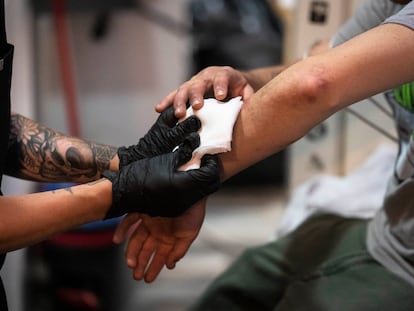Xylazine, the animal sedative adulterating heroin and fentanyl in Mexicali and Tijuana
The drug, which was already used as an opioid adulterant in the US and Canada and which significantly increases the risk of overdose, has now appeared in Mexico


In the narcotics underworld of Mexicali and Tijuana there is a new suspect. On the streets it is known as the “zombie drug.” Many believe it is a horse tranquilizer. Its scientific name is xylazine and it is a veterinary sedative that is combined with other anesthetics and analgesics for operations on small animals, or in laboratories where rodents are experimented on. An unpublished study has discovered traces of the substance in syringes discarded by heroin and methamphetamine users in the two Mexican cities. If the fentanyl crisis had already taken over northern Baja California and other points along the U.S. border, the arrival of xylazine represents yet another lethal risk to already extremely vulnerable drug addicts whose chances of a fatal overdose have multiplied.
It’s rain on wet ground, in the words of Silvia Cruz, a veteran pharmacologist and co-author of the book Lo que hay que saber de drogas (What you need to know about drugs) and a participant in the study, which was financed by the National Council of Humanities, Sciences and Technologies (Conahcyt). This is not a minor fact: considering the official narrative of the Mexican authorities has been to play down the opioid crisis and claim that it only affects the United States, research paid for by a public agency is, in practice, an acknowledgement of the problem and a slight change in discourse.
The results of the research, which have not yet been published, were shared with the National Commission on Mental Health and Addictions (Conasama), which reports to the Ministry of Health. The agency issued a health alert on April 8: “A study carried out in the cities of Tijuana and Mexicali found xylazine as an adulterant in 35 residues of heroin mixed with fentanyl and 26 residues of fentanyl, out of a total of 300 samples analyzed with gas chromatography coupled to mass spectrometry.″
Four days later, Conasama published the first nationwide study focused on the use of fentanyl: “In Mexico, in 2023, 430 cases of care for fentanyl use were recorded, while in 2022 there were 333, which are concentrated in northern states of the country such as Baja California, Baja California Sur, Chihuahua, Sinaloa and Sonora. This shows that the increase is at the local level, not national; however, the main concern revolves around its high lethality.” Although the official results are still low, both investigations highlight the authorities’ concern.
“I see it as an advance, I am very pleased. We consider it a sensitivity that helps to draw attention to the fact that fentanyl has been around for a while,” says Cruz, who also participated in a study that confirmed fentanyl use for the first time in the central region of Mexico, published last December in Harm Reduction Journal.
Used syringes
The team of researchers, led by Clara Fleiz, visited the headquarters of an NGO in each city — Prevencasa in Tijuana and Verter in Mexicali — and habitual places for street consumption. There, they exchanged used syringes for new ones. The objective was twofold: to reduce the risk of disease transmission among addicts and to study syringe residue. This technique has its limitations, explains Cruz: “With a syringe residue you can only tell what is in it, not exactly what the person consumed.” More than 4,000 samples were taken and analyzed in a presumptive study, using strips that reveal whether there has been mixing. Many contained fentanyl and methamphetamine: “People take methamphetamine and bring themselves down with heroin contaminated with fentanyl, or the other way around: they feel very low and look for a high with methamphetamine,” Cruz explains.
Of those 4,000 samples, 300 were selected for a confirmatory study using techniques such as chromatography and spectrometry, “which gives you a fingerprint of what a chemical has in it.” Twenty percent of the 300 syringes contained traces of xylazine. In Mexicali, the presence of the sedative was higher than in Tijuana: 51% of the samples contained the substance.
In the 1960s, following the first studies of xylazine in humans, its use was outlawed because of potent adverse effects. “The first thing it does is it relaxes the muscles; people can’t stand up properly, they fall down, they lie down. It lowers blood pressure and heart rate tremendously. It produces an increase in the amount of sugar in the blood, hyperglycemia, which at the time of overdose can be a problem, and it lowers the respiratory rate, which is very similar to what heroin does. The risk of overdose is very significant,” says Cruz.
Mexico still does not market the antidote for fentanyl overdoses, naloxone, which can be found in any pharmacy in the United States. With xylazine, the situation is more complicated: as it is not an opioid, it requires a much higher dose of the remedy. Legalizing naloxone, experts say, is a matter of life and death. “We are already behind in using it at the border and now it is more urgent,” Cruz says. Unlike mixtures of heroin and methamphetamine, which can be sought by the consumer, adulteration with xylazine is carried out by dealers, not addicts, clarifies the pharmacologist.
Prolonged consumption of xylazine also causes skin lesions around the injection sites. The risk increases if users also take methamphetamine, which is extremely common among heroin addicts. Methamphetamine and xylazine cause vasoconstriction: a narrowing of the blood vessels, like a highway with closed lanes. Blood cannot get through and necrotic ulcers occur: the tissue, the skin, dies. At this point, medical attention needs to be almost immediate. Otherwise, the wound may result in amputation of the affected limbs.
In October 2023, another team of four scientists, including Cruz, published a study in the journal Drug and Alcohol Dependence on the effects of mixing morphine — equivalent to heroin — and xylazine in rodents. The doses of each drug, individually, were high but not lethal. With only one of the substances, the mice survived. “By mixing them, 90% of the animals died. You are increasing the lethality because they both converge to decrease respiration. Since October, several studies have come out [that point] in the same direction,” summarizes the expert.
From Puerto Rico to Philadelphia
Cutting heroin with fentanyl and xylazine is a practice that was already common in the United States and Canada, which issued their own alerts over the use of the veterinary sedative in humans in 2022. The more opioids a user consumes, the shorter the effects last and the sooner withdrawal syndrome appears. Xylazine lengthens the trip.
The use of xylazine to adulterate heroin began in Puerto Rico in the 1980s and soon after made the leap to the continental United States, especially Philadelphia. There, today, “almost all heroin is sold with fentanyl and it is extraordinarily common to mix it with xylazine,” says Cruz. “The phenomenon of drug adulteration is very complex. It obeys market laws, so that it comes out cheaper and hits the consumer harder,” she concludes.
Sign up for our weekly newsletter to get more English-language news coverage from EL PAÍS USA Edition
Tu suscripción se está usando en otro dispositivo
¿Quieres añadir otro usuario a tu suscripción?
Si continúas leyendo en este dispositivo, no se podrá leer en el otro.
FlechaTu suscripción se está usando en otro dispositivo y solo puedes acceder a EL PAÍS desde un dispositivo a la vez.
Si quieres compartir tu cuenta, cambia tu suscripción a la modalidad Premium, así podrás añadir otro usuario. Cada uno accederá con su propia cuenta de email, lo que os permitirá personalizar vuestra experiencia en EL PAÍS.
¿Tienes una suscripción de empresa? Accede aquí para contratar más cuentas.
En el caso de no saber quién está usando tu cuenta, te recomendamos cambiar tu contraseña aquí.
Si decides continuar compartiendo tu cuenta, este mensaje se mostrará en tu dispositivo y en el de la otra persona que está usando tu cuenta de forma indefinida, afectando a tu experiencia de lectura. Puedes consultar aquí los términos y condiciones de la suscripción digital.
More information
Archived In
Últimas noticias
The digitalization of tourism: ‘They promise experiences and gave us the worst possible one’
Mexican peso defies uncertainty with forecasts of a new period of stability in 2026
Meghan Markle’s year of redemption: Numerous projects, some setbacks and a brand that is finally taking off
David King, chemist: ‘There are scientists studying how to cool the planet; nobody should stop these experiments from happening’
Most viewed
- Sinaloa Cartel war is taking its toll on Los Chapitos
- Oona Chaplin: ‘I told James Cameron that I was living in a treehouse and starting a permaculture project with a friend’
- Reinhard Genzel, Nobel laureate in physics: ‘One-minute videos will never give you the truth’
- Why the price of coffee has skyrocketed: from Brazilian plantations to specialty coffee houses
- Silver prices are going crazy: This is what’s fueling the rally










































